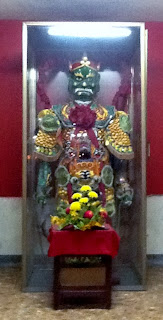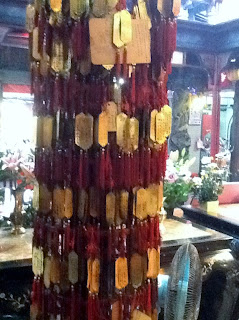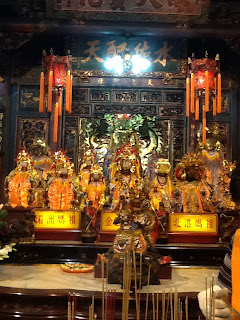Marine folklore
is filled with tales of catastrophes averted when the goddess Mazu, dressed
in red, appeared to sailors as a warning that unseen storms were rising and
that their voyages should be postponed. Many a seafarer has recounted times
when the goddess Mazu appeared as a bright light on their troubled ships,
arriving just in time to calm a storm and save their lives. Some said that
Lin Mo could actually ride clouds across the ocean, and appear in the flesh
to rescue them.
Like Kuan Yin,
the goddess Matsu decided not to marry in spite of immense social pressure to
do so. Two warriors of great fame became inflamed with lust when they saw the
beautiful young girl and wanted to "marry" her. She challenged the
pair to fight her for the privilege, insisting that they would have to do her
bidding forever if she won. Remember learning the martial arts have long been
a part of the training of Buddhist priests and undoubtedly was part of her
studies as well. All I have to say at this point is yet another example of
men believing they know everything about women. You can imagine how that
fight ended. General Chien-li-yen (Eyes that See a Thousand Miles) and
General Shun Feng Erh (Ears that Can Hear the Wind) died that day during the
fight that took place on Mount Peach Blossom. To this day, the pair of
defeated warriors are by her side in statuary in her temples.

The is General Shun Feng Erh. It is not clear weather this general was elevated to the status of god after Matsu killed him. He and General Chien-li-yen are in every temple dedicated to the goddess of the open sea. This is the one who can hear the wind. The ears on this statue are huge.
 This is General Chien-li-yen. This is the warrior who can see for a thousand miles. The children here are told to be careful of what they say and do. These two gods catch you and you will be sent to one of the 18 levels of hell.
Lin Mo's died at
the age of 28. She climbed mountain and when she reached the top was encircled
by clouds of dense fog. The sound of enchanting celestial music flied the air
and she was carried into the heavens in a golden glow of light. Where she was
last seen, a great rainbow appeared. And this was God’s promise to never
flood the Earth again. Ooops wrong religion. The rainbow in the Chinese
culture symbolizes good fortune.
Jing-Xi’s Thought of the Day…
Showing the proper respect for other cultures does not insinuate
a belief in their religious practices.
I am certain it is viewed as narrow minded to believe in one thing and only
in one way. But it is that narrow mindedness which gets one through the
nights. I have arrived at the forgone conclusion tradition is deeply rooted in
every society. People of different cultures take offence when their beliefs
are flippantly questioned or taken as jest. It does sadden my heart to think
people rely on luck for answers to their prayers. How does one sleep at night
depending on nothing or luck?
 The outside of the temple. Under this roof what would have been the treasury in old times. The guy on top is a scary god who guards Matsu's money. I am not sure why she needs money, but you get the idea.
 Same scary guy. I never did get this god's name. I just know the natives are very afraid of his wrath.
 More temple adornment. Hand crafted and painted by dedicated and talented worshipers.
 This is outside the main doors. It is a giant incense burner. A temple priest whose only job is to make sure there are always stick of incense burning, even if there are no patrons in the temple. There are smaller versions of this holder scattered through out the temple. My first thought was maybe someone finally realized how smelly this country truly is decided to make it smell nicer. I am sure that is the reason. :)
 This is a giant golden statue of a dragon looking sea serpent scary animal thing. I believe it is encased in glass because it is made from precious metals. The dragon sea serpent rotates on some type of lazy susan, for lack of a better term. The face of this creature looks fierce and is meant to be a warning to evil doers. The stone carving behind the case fetches the people who have committed a wrong. I am not sure what type of animal it is supposed to be, but it looks part dog, lion, and dragon. I guess if the wrong doer doesn't want to come quietly, the dog lion thing will devour the person whole on the spot. Talk about twisted bed time stories. It is a wonder to me how Asian mothers get their children to sleep at all. "You better shut your eyes and go to sleep right now. Or the dragon sea serpent's dog lion thingy will come and eat you up!" That would put them right to sleep...
 This man is filing his "wish" which is what we would call a prayer. I am still very confuse about this part of the temple experience. I did get a proper explanation, but... From what I gather, the person makes a wish and if it is of the private nature they file it in the drawers you see in the picture. I wonder why a "god" would need a filing system?
 There are many small statues spread out through the temple. I do not know if they have some purpose, other than decoration. This one is a lion and sits in front of hand carved columns. It is a truly amazing sight.
 Another hand carved column. This is of trees and fish.
 This is the god of water, or so I was told. The statue is behind glass and the red lights in back look like eyes staring at you. This is another god meant to scare people into doing good. The table in front has food offerings and there is an incense holder behind the offerings.
 This is yet another god. I am not sure which one he is, but he is also behind glass. There are offerings on a table in front to this god too. This one doesn't look so scary and mean. I guide said a prayer and bowed to this god several times. I was so excited and overwhelmed by the things to see, I was pointing at the gods as I asked questions. I was told pointing at the gods offended them greatly and I needed to apologize. I apologized for the offence and we moved on.
This woman is praying to Matsu. They light the incense, place it in the holder and bow to the god. They say their prayer quietly and bow after every request. I watched this woman bow over 15 times. Also I want to point out the neon sign up high and in front of her. Most of the large temples have these signs and are lighted by neon signs at night. Maybe churches in America need to adopt this practice. The sign could say. Hey heathens! This is a church. Come in here, repent of your sins, or you will go to hell. Oh and by the way, Jesus loves you.
 Gold inlay art work on the doors of the temple. This picture was huge. This is of a guy who no one seemed to know. They just know he guards the door to the temple and his wife is on the other door. I did not get a picture of her because the door was propped open.
 This is where the temple worshipers go to buy their "gifts". This is a picture of the incense area. The red packages smell very good and I bought some to bring back to the dorm with me.
 This is paper fake money. The practice is to burn money so your ancestors will have enough money to buy their way into heaven. In one of my last posts there was a picture of a pig and a fire. This is what they were burning in the fire.
 Behind the collection box are gold looking tags on a red cord. These are wish tags. I am not sure the natives call them wish tags, but this is their purpose. People buy the tags, write their wish down, and hang it on a special column in the temple. If the great goddess Matsu believes that you should be granted your wish, it comes true. She does not grant all of the wishes, but it is said that she does guard them to keep them safe.
 This is the collection box. This is similar to the offering plate in American churches. The marked difference is that you get a tangible item for your donation and every item costs 200NT. This is roughly 7 USD.
 This is a picture of the temple outside. It had hand carved decorations every where you looked. I thought this one to be especially neat looking. The decorations all have special meanings, but with so many it was hard to keep them all straight. What I took away from the explanations was the patrons live in fear of their gods.
 This is where the patrons can go to burn the paper money. I was told this is an environmentally friendly way to burn the paper money, but some people still prefer the old method. The old method being burning it in the streets.
 This is the entry gate to the temple. Even the gate has some sort of special meaning.
 This is a bigger version of the dog, dragon, lion thing sitting behind the dragon sea serpent thing. There are two of these huge carvings sitting on either side of the gate to Matsu's temple.
The giant dog, dragon, lion thing are called imagination
animals. They sit on either side of the gates to temples. The natives believe the animals are put there
to remind you of the reason behind your temple visit. It is said they help you clear
you mind of the daily stresses, worries, but most importantly they help you
focus on worshipping the gods properly in the temple. (Thank you Rachel for the
help in explaining the dog, dragon, lion thing. I love you sweet girl!)
If this is what comes to get you when you do a bad thing. I have seen the light! I am a reformed bad deed doer. Holy cow this thing looks scary.

This is the wish column I mentioned above. This is where you can hang your wish. The word wish here does not mean a hope or desire for something to pass. What the word wish actually refers to is a prayer. These are prayers people have said and hung up here. I guess in a way these could be wishes, but wish sounds to me like taking a chance. I was told I could make a wish and hang it up, if I wanted. I politely declined. Our guide asked why I wouldn't want my wishes to be considered by Matsu. I politely explained my trouble with apologizing to the gods for pointing. I only apologized because I did not want to offend the real people in the temple who take their religion seriously. I told him I believed that it would be even more of an offence if I were to make a wish and not believe in any of the gods. He agreed and we moved on.
 These are prayer dice and they are sitting on another collection box. The sign here also says 200NT. This buys you three rolls of the prayer dice. They do have a Chinese name, but was very difficult to pronounce, let alone recall at a later date. The name of these items is not subject matter. The subject is what the natives do with these items. As I mentioned above you are allowed three (3) rolls per 200NT. Again, for those who rode the short bus to school, that is roughly 7$ USD. They take the dice in hand, hold them very near their mouth and whisper their prayer/wish, bow to the goddess Matsu three (3) times, and cast the dice. One side of the die is rounded and one side is flat. You want the dice to land round side up and flat side up, so one of each. If your cast comes up one round side and one flat side up this means your wish/prayer is granted. If you roll anything else you just pick the prayer dice up, make your wish, bow, and cast them again. I watched a man drop 1000NT (approx. 35$ USD) into the collection box. This bought him five (5) separate turns with the dice. I don't speak blah blah so I am not sure what he was praying for or if it was the same prayer. At this point my true nature started to bubble through my self control. I feared I would make a sarcastic comment and offend my guide and everyone in the temple. In utter disbelief and sadness, over the fate of the native's souls I left Matsu's temple. I am not sure I want to go back to a temple. How reassuring can people find it to blindly put their trust and faith into a institution that reminds me of Las Vegas. If I don't roll snake eyes, god won't listen to my request...
|
 This is one of the games the children play. It is a type of fishing game. There are live fish in the orange tub. They have little fish of every color, crabs, and crawfish. They use the net you see and scoop the animals and put them into a holding container floating in the water. When the container is full they dump the contents and begin fishing again. This game does seem a little inhumane, but the children are very careful not to hurt the creatures in the tub. The orange tubs also have a constant flow of water in and out to ensure they live long enough to caught and terrorized by as many children as possible.
This is one of the games the children play. It is a type of fishing game. There are live fish in the orange tub. They have little fish of every color, crabs, and crawfish. They use the net you see and scoop the animals and put them into a holding container floating in the water. When the container is full they dump the contents and begin fishing again. This game does seem a little inhumane, but the children are very careful not to hurt the creatures in the tub. The orange tubs also have a constant flow of water in and out to ensure they live long enough to caught and terrorized by as many children as possible.  Upon first glance you're not sure what these really are. But when you inspect them closly you realize they are duck heads and necks. People eat these horrible looking items wih rice or noodles. They clean the meat off the bones and save the most delicious parts for last, the eyes.
Upon first glance you're not sure what these really are. But when you inspect them closly you realize they are duck heads and necks. People eat these horrible looking items wih rice or noodles. They clean the meat off the bones and save the most delicious parts for last, the eyes.  These are, for lack of a better way to describe them, rotten eggs. They are not really rotten, but it is hard to explain how they prepare these for human consumption. They are some how aged and fit for humans to eat. However, those reading this know I would never let one of these vile looking items any where near my mouth, let alone actually take a taste.
These are, for lack of a better way to describe them, rotten eggs. They are not really rotten, but it is hard to explain how they prepare these for human consumption. They are some how aged and fit for humans to eat. However, those reading this know I would never let one of these vile looking items any where near my mouth, let alone actually take a taste.  These are plates of dired sea creatures, mostly shrimp in variying sizes. They are covered in plastic to keep the bugs out of the product. These are used in cooking and they add them to soups. I did see some people walking around eating these items out of a paper cup. The smell of the seafood is enough to gag a maggot and we all know what they eat...
These are plates of dired sea creatures, mostly shrimp in variying sizes. They are covered in plastic to keep the bugs out of the product. These are used in cooking and they add them to soups. I did see some people walking around eating these items out of a paper cup. The smell of the seafood is enough to gag a maggot and we all know what they eat... 





























